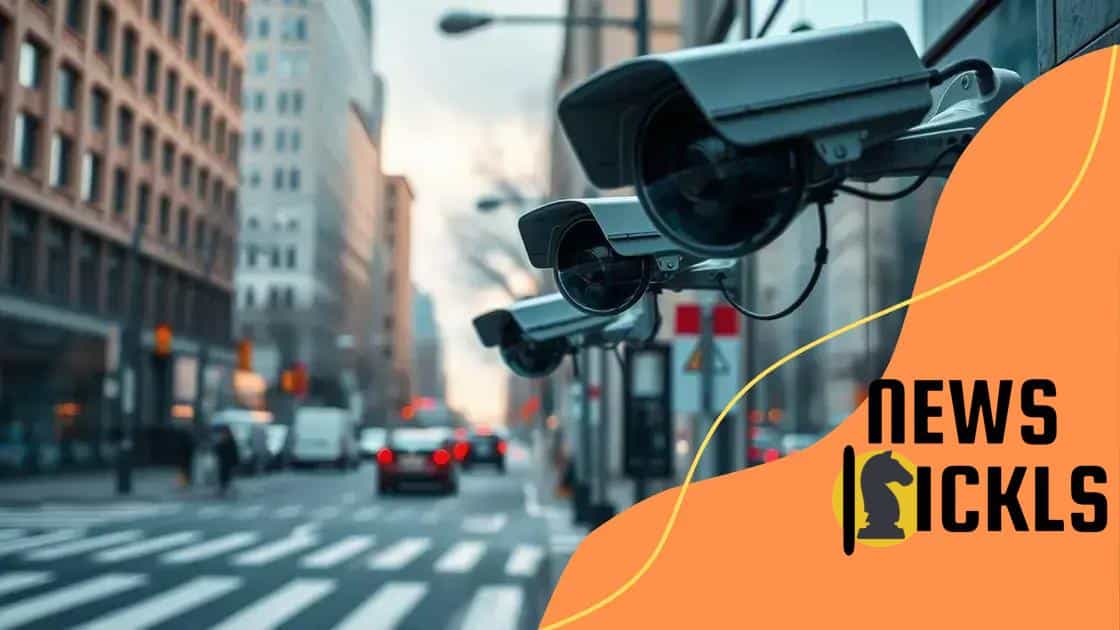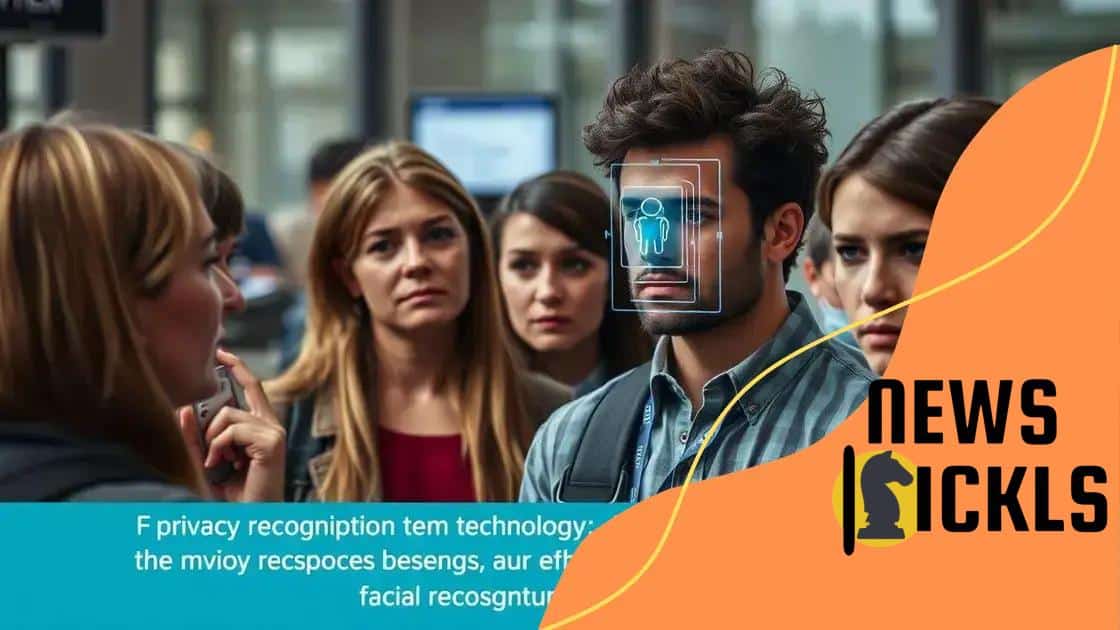The role of facial recognition in enhancing public safety

The role of facial recognition in enhancing public safety includes improving crime prevention, enabling rapid identification of suspects, and increasing security at public events while raising ethical concerns around privacy and bias.
The role of facial recognition in enhancing public safety is a hot topic that raises numerous questions. Have you ever wondered how this technology impacts our daily lives and keeps us safe?
Understanding facial recognition technology
Understanding facial recognition technology is essential to grasp its impact on public safety. This sophisticated technology uses algorithms that compare facial features from images or video with a database. By analyzing these features, it can identify or verify an individual’s identity effectively.
Facial recognition works by capturing an image, breaking it down into key components, and then matching it with existing data. One main area of application is in law enforcement, where it aids in identifying suspects during investigations.
Key components of facial recognition technology
There are several pivotal elements that support facial recognition:
- Image Capture: High-resolution cameras are used to capture clear images necessary for accurate analysis.
- Feature Extraction: The technology identifies significant features such as the distance between the eyes and the shape of the jawline.
- Database Matching: Extracted features are then compared against stored images in a database.
- Feedback Loops: Systems continually learn and improve their accuracy with new data.
Besides law enforcement, facial recognition is also present in various sectors, including security at airports and banks. This versatility highlights its growing importance in enhancing public safety.
As technology continues to evolve, our understanding of how facial recognition integrates into daily life will also advance. Awareness and education about its benefits and limitations are vital as society navigates this complex landscape.
Benefits of facial recognition for public safety
The benefits of facial recognition for public safety are vast and transformative. This technology has the potential to enhance security measures across various sectors. By providing accurate identification, it aids in preventing crime and enhancing emergency response times.
One significant advantage is the ability to quickly identify individuals who pose a threat. For instance, in a crowded area, security personnel can use facial recognition systems to flag known offenders and respond proactively.
Key advantages of facial recognition in public safety
Here are some notable benefits:
- Speed: Facial recognition can match faces against databases in real-time, allowing for swift action when necessary.
- Accuracy: The technology has improved considerably, reducing the chances of false positives and increasing reliable identifications.
- Deterrence: The presence of facial recognition cameras can discourage criminal activity, knowing individuals are being monitored.
- Efficient resource allocation: Authorities can focus their efforts where they are needed most, improving overall efficiency in public safety.
Another benefit is the technology’s integration with other systems. For example, combining facial recognition with surveillance cameras provides deeper insights into public safety challenges.
Incorporating facial recognition into public safety frameworks has led to smarter policing strategies. Officers equipped with mobile devices can access identity information instantly, enabling them to make informed decisions on the spot.
As this technology continues to evolve, its potential to enhance safety remains promising. Public awareness and understanding of its benefits are crucial for its successful implementation in various environments.
Challenges and ethical concerns

While the use of facial recognition technology offers numerous benefits for public safety, it also comes with several challenges and ethical concerns. Understanding these issues is crucial for responsible implementation.
Privacy is one significant concern. Many people feel uncomfortable knowing that their faces can be scanned and identified without their consent. This raises questions about whether it’s fair for authorities to monitor individuals constantly.
Key challenges with facial recognition technology
Some of the most pressing challenges include:
- Accuracy: While technology has advanced, it can still lead to false positives, which may misidentify innocent people.
- Bias: Studies have shown that some facial recognition systems may perform poorly on individuals with darker skin tones, leading to higher rates of misidentification.
- Accountability: When mistakes happen, it is often unclear who should be held responsible, raising concerns about justice and oversight.
- Surveillance: The potential for widespread monitoring can create a culture of surveillance, where people feel they are always being watched.
In addition to these challenges, the ethical implications of deploying facial recognition technology must also be considered. For instance, using it in protests or public gatherings can potentially infringe on the right to free speech and assembly.
To address these concerns, it is essential for companies and governments to establish clear regulations for the ethical use of facial recognition. Transparency in how the technology is used and ensuring public consent can help build trust with communities.
Real-world examples of facial recognition
Real-world examples of facial recognition highlight its practical applications and effectiveness in enhancing public safety. This technology is increasingly being used across various industries, showcasing its potential in real-time scenarios.
One prominent example is its use in airports for security screening. Many airports have implemented facial recognition systems to speed up the check-in process and enhance security. Passengers scan their faces at kiosks, allowing quick identification and verification before boarding flights.
Key applications in different sectors
Here are some notable instances:
- Law Enforcement: Police departments use facial recognition to identify suspects captured on surveillance cameras. This was effectively seen in urban areas where crime rates are higher.
- Retail: Stores implement facial recognition to analyze customer behavior. By identifying returning customers, retailers can tailor their services accordingly.
- Public Events: Major events, such as concerts or sports games, utilize this technology to ensure safety by monitoring crowds and identifying potential threats.
- Healthcare: Hospitals use facial recognition to enhance patient security by ensuring that only authorized personnel can access sensitive areas.
These real-world applications illustrate how facial recognition can contribute significantly to safety and efficiency. As these examples demonstrate, this technology serves various practical needs, making an impact on how we approach security.
In the future, further advancements in facial recognition technology will likely enhance its effectiveness, expanding its use across even more sectors.
Future trends in public safety and technology
Future trends in public safety and technology are continually evolving, driven by advancements in digital tools. The integration of cutting-edge technologies promises significant changes in how societies approach safety.
One major trend is the increased use of artificial intelligence in facial recognition systems. AI can improve accuracy and efficiency, making it easier to identify threats in real-time. As technology progresses, we can expect smarter algorithms that learn from past data to enhance their identification capabilities.
Emerging technologies influencing public safety
Several new technologies are likely to play a key role:
- Machine learning: This will enable systems to adapt and refine their processes based on new information, improving responsiveness to threats.
- Internet of Things (IoT): Smart devices connected to networks can provide valuable data for real-time monitoring and response in public safety scenarios.
- Blockchain: Enhancements in data security and transparency through blockchain technology can improve trust in how facial recognition data is used and stored.
- Augmented reality: AR can assist law enforcement during operations, providing officers with real-time data overlays to enhance situational awareness.
With these advancements, cities will become more intelligent ecosystems. Smart city initiatives are already in progress, where different technologies work together to create a safer environment for residents. As facial recognition becomes more widely accepted, it may integrate with broader smart city applications to enhance overall security.
It is essential to balance these technological advancements with ethical considerations. Continued dialogue around privacy and the responsible use of technology will shape the future of public safety.
facial recognition in enhancing public safety is significant yet complex. While technology offers many benefits, such as faster response times and improved crime prevention, challenges around privacy and ethics remain. As we look to the future, balancing these aspects will be essential. By embracing innovation responsibly, we can utilize facial recognition and other emerging technologies to create safer communities, while also respecting individual rights and freedoms. Open discussions about the ethical use of technology will help shape a secure, yet equitable environment for all.
FAQ – Frequently Asked Questions about Facial Recognition and Public Safety
How does facial recognition technology enhance public safety?
Facial recognition technology helps identify and track individuals, enabling quicker responses to potential threats and improving overall security measures.
What are the ethical concerns surrounding facial recognition?
Ethical concerns include privacy violations, potential misuse of data, and the risk of bias in identification, especially against marginalized groups.
What are some real-world applications of facial recognition?
Real-world applications include airport security screening, law enforcement investigations, and monitoring large public events for safety.
What should be considered for the responsible use of facial recognition technology?
Responsible use involves ensuring transparency, obtaining consent, and addressing privacy rights to build public trust in the technology.






